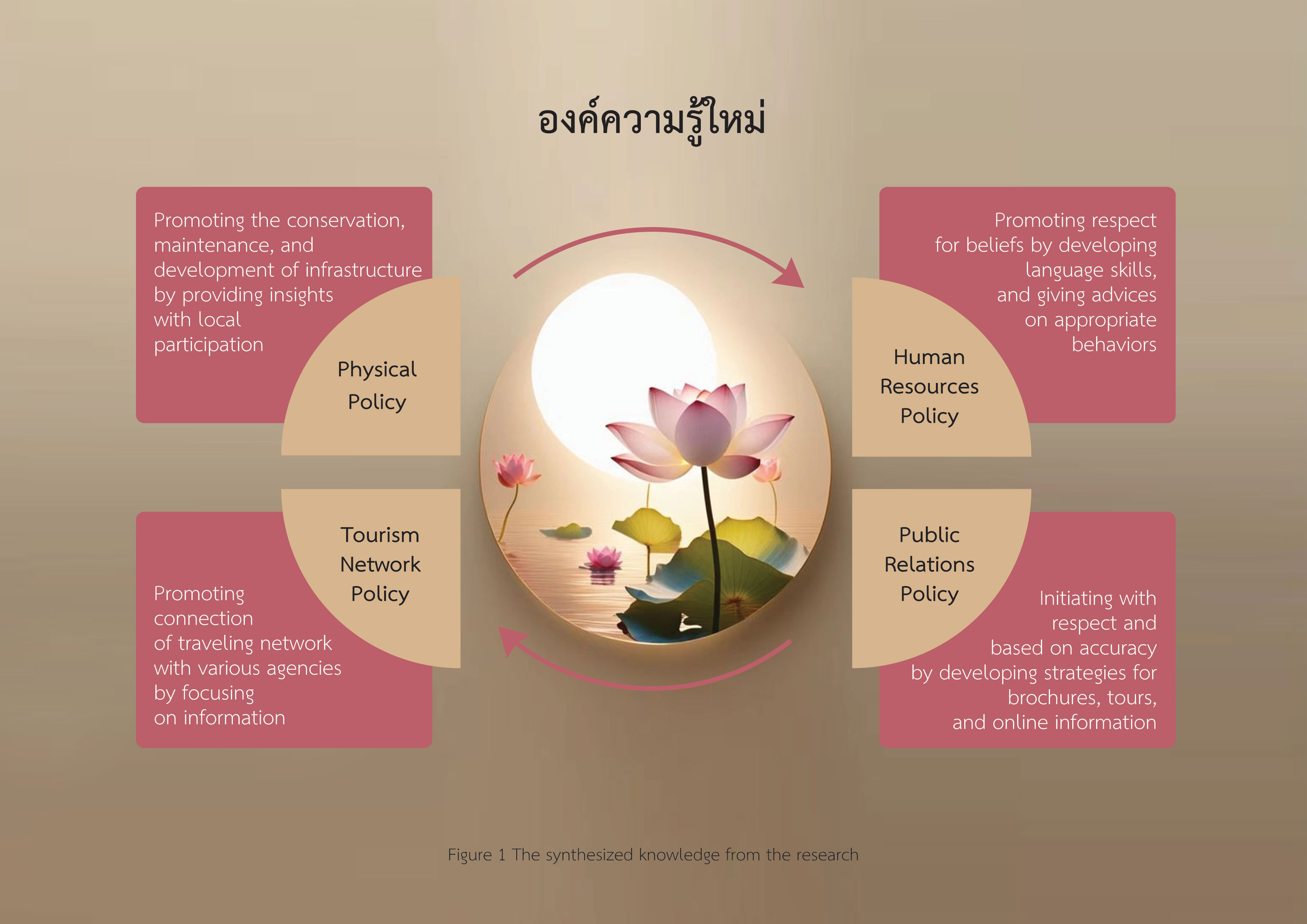THE POLICIES TO PROMOTE BUDDHIST TOURISM OF WAT THAT NOI, CHANG KLANG DISTRICT, NAKHON SI THAMMARAT PROVINCE
Keywords:
Policy, Promotion, Buddhist Tourism, Wat That NoiAbstract
Background and Objectives: Tourism is considered important to the economy and is the main source of income for Thailand. Therefore, the government plans and adjusts tourism policies, including the national strategy regarding travel continuously. By promoting the distribution of tourism travel and tourism growth, and fostering links between provincial and regional groups, the government aims for building the ability to effectively support tourists who visit Thailand. Additionally, Buddhist tourism provides a source of art collection, technology, and knowledge across various branches. It encompasses valuable works of art such as ancient sites, antiques, murals, and various other cultural artifacts, which are considered to be priceless cultural heritages and contribute to the unique identity of the Thai nation. Consequently, there is a policy to encourage all sectors of society, both public and private, to be aware of its importance and participate in organizing religious tourism projects. The objectives of the research are to study the policies to promote Buddhist tourism of Wat That Noi and to study the suggestions for the policies to promote Buddhist tourism of Wat That Noi in the Chang Klang District of Nakhon Si Thammarat Province.
Methodology: This study employed mixed methodology with a scope of content covering Buddhist tourism promotion policies, which included physical policy, human resources policy, public relations policy, and tourism network policy. It also included a summary of interviews with key informants in terms of suggestions for the policies to promote Buddhist tourism, which comprised the aspects of physical policy, human resources policy, public relations policy, and tourism network policy. The sample comprised 383 individuals who visited Wat That Noi in terms of Buddhist tourism from July to December of 2023. Key informants comprised a total of 20 individuals, which included a group of tourism academics, a group of ecclesiastical administrative officers, a group of local administrative officers, a group of tourists, and a group of tour guides. Data collection involved in-depth interviews and questionnaires, with a reliability coefficient of 0.778. Data analysis utilized basic statistics, including percentages, means, and standard deviations.
Main Results: The study found the respective findings. First, Buddhist tourism knowledge manifested in the form of faith and belief, providing psychological value for tourists who visited and worshiped. Second, physical policy aimed to ensure temple conservation and maintenance, develop infrastructures, develop transportation, develop information dissemination, reduce environmental impact, and encourage respectful behaviors at religious sites. Third, the human resources policy underlined training and language skill development for personnel to facilitate effective communication. Fourth, public relations policy aimed to initiate respectful engagement with Buddhist culture, traditions, and beliefs through online resources. Fifth, the tourism network policy aimed to build partnerships with travel agents and tour operators that specialized in spiritual or religious tourism, which built the cooperation with various agencies that served tourists with good quality services that connected provinces and regions through land and air transportations and could have connected each context in each area.
Involvement to Buddhadhamma: This article of Buddhist innovation included Buddhist principles for promoting Buddhist tourism, which consisted of Saddhā (Faith) and Pasāda (Confidence). Faith, often coupled with belief, embodied the concept of Saddhā-Pasāda, which implied being confident by faith or being both confident and faithful.
Conclusions: The application of knowledge of the policies for promoting Buddhist tourism was the integration between tourists' physical and spiritual experiences at Buddhist tourist attractions, which fostered visitors' faith and confidence in the religion and the places of worship.
References
Boonyaphak, W. (2007). Tourism resource management. Sukhothai, Thailand: Sukhothai Thammathirat Open University.
Bowonkulpa, B. (2014). The Need to Develop Community Temples in The Thonburi Area to Become Tourist Destinations. [Unpublished master's thesis]. Siam University. Bangkok, Thailand.
Chomphuwong, S. (2011). Social Science Research Methods (2nd ed.). Nakhon Si Thammarat , Thailand: Mahamakudraj University, Srithammasokrat Campus.
Department of Religious Affairs, Ministry of Culture. (2014). Guidelines for the Implementation of Tourism Promotion Projects on Pilgrimage Routes in Religious Dimensions in 2014. Bangkok, Thailand: Department of Religious Affairs, Ministry of Culture.
Khamsri, W. (2024). The Policies to Promote Buddhist Way of Tourism. (Yiamsuan, A., Interviewer).
National Statistical Office. (2014). Survey of Travel Behavior of Thai People 2014. Bangkok, Thailand: Office of Forecasting Statistics, National Statistical Office.
Phrakhru Phawanaphothikhun Somchai Kantasilo & Phra viman Gambhirapanno. (2017). The Support of Public Mind to Preserve the Touring-Places of the Buddhist Temples in Muang Khonkaen District, Khonkaen Province. [Research report, Mahachulalongkornrajavidyalaya University, Khonkaen Campus]. DSpace at Mahachulalongkornrajavidyalaya University. http://mcuir.mcu.ac.th:8080/jspui/handle/123456789/428.
Phrakru Udonphawanakun Sajjasapho. (2020). Promoting Approach for Buddhist Tourism Management of Temples in Nayung District, Udonthani Province. Journal of MCU Peace Studies, 8(3), 1024-1037.
Phramaha Samran Thanuttamo Prasertsueng. (2018). The Monasteries Management for Cultural Tourism Attraction of Samutsonkhram Province. [Unpublished doctoral dissertation]. Mahachulalongkornrajavidyalaya University. Phra Nakhon Si Ayutthaya, Thailand.
Prasasakul, L. (2012). Tourist Behavior. Bangkok, Thailand: V.Print (1991) Company Limited.
Saefang, Y. (2021). Taking Tourism Promotion Policy for Implementation for Personnel of Mae Hong Son Provincial Administrative Organization. Journal of Arts Management, 5(1), 134-149.
Saelee, T. (2018). Suitable Community Tourism Management Network Model of the Ali Community and Ban Om Kaew Community Surin Province. [Unpublished master's thesis]. Ubon Ratchathani University. Ubon Ratchathani, Thailand.
Somanat, J. (2024). The Policies to Promote Buddhist Way of Tourism. (Yiamsuan, A., Interviewer).

Downloads
Published
How to Cite
Issue
Section
License
Copyright (c) 2024 Journal of Buddhist Anthropology

This work is licensed under a Creative Commons Attribution-NonCommercial-NoDerivatives 4.0 International License.







